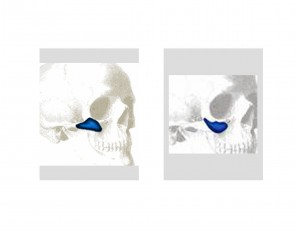Implant augmentation of the cheeks provides a valuable facial structural enhancement as well as is useful for an anti-aging effect. For many women, it may be the most critical aesthetic facial prominence (short of the nose) in contrast to men where it is the chin and the jawline. The cheek in both genders, however, can make the face more bold, defined and attractive. But cheek augmentation is a procedure that is harder to predict the implant’s effect on males or females because it is a curved facial feature that defies any exact mathematical measurement like most other facial features.
When one factors in the many different styles and sizes of cheek implants, not to mention the different manufacturers and materials, there may be upwards of near 100 different cheek implants to choose from. How does one know what is the best cheek implant to choose for this midfacial area? There are numerous factors to consider but the first is to recognize the gender differences in desired cheek shapes. Men desire and look better with a more chiseled cheek appearance that is often described as angular . This is a high more sharply defined cheek look. Conversely, women usually desire and look better with a less angular fuller cheek. This round cheek creates a softer more feminine appearance.
Because the cheek is not seen at its best in either a frontal or a profile view, it defies any exact measuring system. The influence of the cheek is best seen in a quarter or oblique profile view which is how most people see your face anyway. It is possible to isolate the most optimal area of cheek enhancement by the intersection of an oblique line drawn from the corner of the mouth to the corner of the eye and a horizontal line drawn outward from the top of the nostrils. Higher up from this intersection is where male cheek prominence should be while more near the intersection is where female cheek prominence should be. But no measurement can tell one about the best cheek implant size. This is where the role of intraoperative implant sizers and the aesthetic judgment of the surgeon comes into play.
Cheek implants are used for four types of aesthetic facial issues. The most common indication is for inadequate cheek volume or an underdeveloped cheek area. The cheeks simply did not develop with the desired amount of aesthetic projection. Asymmetry of the cheeks is another indication which can occur from mild to more severe forms of facial hypoplasia or from cheekbone fractures that were not adequately treated or not diagnosed at the time of the injury. Ethnic cheek augmentation is a third use of implants that represent a form of cheek ‘underdevelopment’ but is really more of an effort to change one’s basic facial shape.This is most commonly seen in Asian and African-American patients where improved cheek projection is desired as one of the maneuvers to change their facial shape. Lastly, which is not really a bone-problem, are the effects of aging. The soft tissues of the cheek are pulled downward towards the mouth area, revealing what appears to be a cheek deficiency. Pushing the soft tissue upwards with an implant is more important here than pure bone augmentation.

One cheek implant issue that is chronically debated is the choice of implant material, which is fundamentally either silicone or Medpor. While there are advocates of either material, what really matters is whether it have the right shape for the area of desired cheek augmentation. Your body does not really care which material is implanted. It will react the same by enveloping it a capsule of scar. The only real difference is that a Medpor implant will be harder to remove or adjust its position but not impossible. Regardless of the material, it is always best to secure the cheek implant into permanent position with a self-tapping 1.5mm screw, one for each side.
Dr. Barry Eppley
Indianapolis, Indiana


